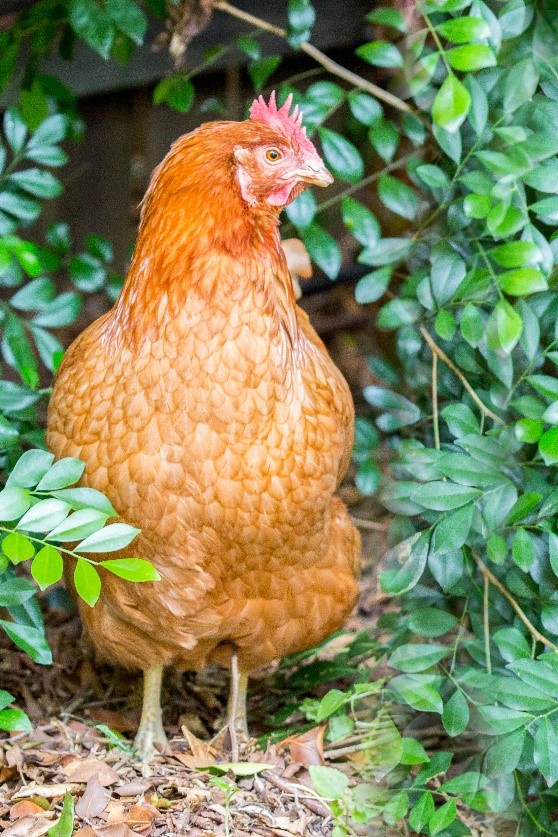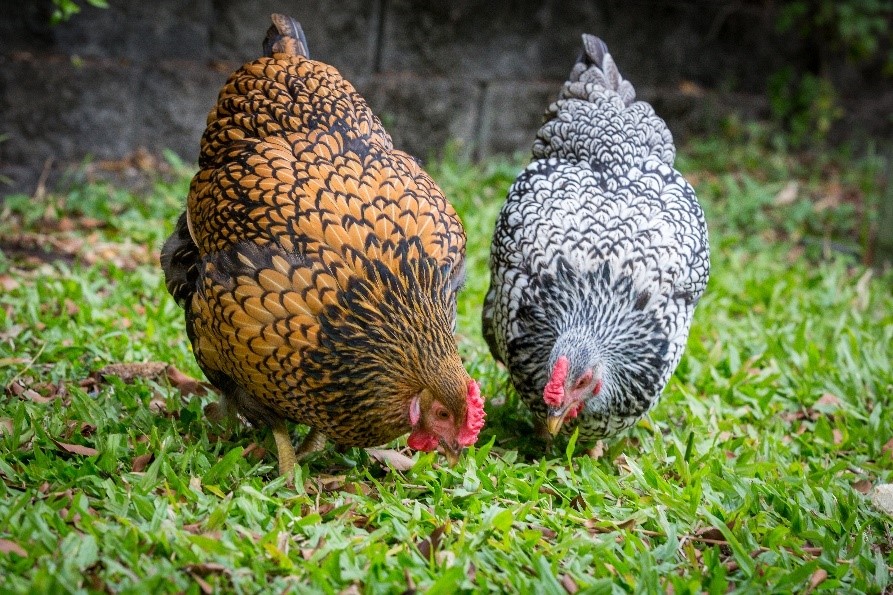Even though they have been domesticated for thousands of years, different breeds of chicken have been developed under the influence of geographical isolation and selection for desired characteristics (e.g., egg laying, show quality, etc.) creating regional types (breeds) with distinct physical and behavioural traits passed on to their offspring.
There are now hundreds of chicken breeds available around the world today – too many to provide detail on their individual characteristics and qualities here. But there are some general questions you might want to consider that can help you choose the right chickens for you:
- Do you want to adopt rescue hens or buy a specific breed?
- What age of chicken would you like and would work for your situation?
- What size of chicken would you like and would work for your situation?
- What space do you have for your chickens?
- For you, what is the most important characteristic of your chickens? e.g., personality, ease of handling, appearance, place of origin, egg laying capacity, egg colour?
The following is some general information about a selection of chicken breeds that people may consider for their backyard flock. It is important to thoroughly research the kind and breed of chicken you are considering.
Large breeds (4-5kg) include:
- The Brahma chicken, one of the largest chicken breeds, is a dual-purpose breed (reared and kept for both meat and eggs). They are a notably heavy chicken, growing up to 4–5 kgs (the roosters are a little heavier than the hens), and up to 75cm tall! They will lay up to 120 eggs each year. They can also make great backyard pets, known for being calm, very friendly, and approachable.
- The Malay chicken can grow up to 90cm in height and weigh 4-5 kgs. Malays have a very erect posture with long, muscular legs, a long, strong body shape, and a long neck. They lay between 70-120 eggs each year and this number declines as they get older. They are primarily kept for showing. They are considered to be quite aggressive towards other chickens and people and, so, may not be a good choice for families with children or for first-time chicken owners.
Medium sized breeds (2.5-4kgs) include:
- The ISA Brown: ISA stands for Institut de Sélection Animale, the company which developed the crossbreed in 1978 for egg production in intensive, battery cage farming systems. It is thought to be the result of a complex series of crosses including but not limited to Rhode Island Reds and Rhode Island Whites, and contains genes from a wide range of breeds, the list of which is a closely guarded secret. The ISA Brown breed is known for its high egg production of approximately 300 eggs per hen in the first year of laying. The ISA Brown is the most common commercial layer hen breed in Australia and so usually the most common ‘rescue’ hen available.

A ‘rescue’ ISA Brown hen living happily in a backyard flock after a life as a commercial layer hen. Photo credit: Sarah Burke. - The Sussex: The Sussex is a British dual-purpose breed. It is the oldest British chicken breed, dating back to the early 1800s. It was traditionally reared for meat production, especially in the early part of the twentieth century, until it was displaced by modern industrial hybrid lines. Sussex hens lay some 180–200 tinted eggs per year; some layer strains may give up to 250.
- The Wyandotte: The Wyandotte is an American breed of chicken developed in the 1870s. The Wyandotte is a dual-purpose breed. They lay up to 200 eggs a year.

Two companion (pet) wyandotte chickens (a golden laced wyandotte and a silver laced Wyandotte). Photo credit: Sarah Burke. - The Araucana: The Araucana is a breed of domestic chicken from Chile. It lays blue-shelled eggs, one of very few breeds that do so. The Araucana chickens may be either normally tailed or rumpless. The Araucana lays approximately 250 blue or green eggs per year.
- The Australorp: The Australorp is a chicken breed of Australian origin, developed as a utility breed with a focus on egg laying. They lay approximately 250 light-brown eggs per year.
- The Rhode Island Red: The Rhode Island Red is an American breed of domestic chicken. It was originally a dual-purpose breed; but the modern strains have been bred for their egg-laying abilities. This breed lays approximately 200–300 brown eggs per year.
- Orpington: The Orpington is a British breed of chicken, originally intended as a dual-purpose bird. They lay about 175 to 200 eggs per year.
The small breeds (0.5-1kg) include:
- The bantams: These are actually not a breed themselves, but a bantam is any small variety of any chicken breed – most large chicken breeds have a bantam counterpart, which is much smaller than the standard-sized fowl, but otherwise similar in most or all respects. They often weigh as little as 500g. They require less space and food than their full-sized relatives and are usually easy to handle. They lay smaller eggs but are good layers, similar to their larger counterparts. Many bantam breeds make wonderful pets thanks to their docile, friendly natures. They are very social, usually happy to be picked up and handled, even by children, and enjoy keeping you company in the garden.
- There are a few true bantam chickens, naturally small and with no large counterpart. They include the Pekin and Silky bantams. Although they have no larger relatives, they share many of the characteristics of the bantams described above.
- Pekin Bantam: The Pekin Bantam is a British breed of bantam chicken. It derives from birds brought to Europe from China in the nineteenth century and is a true bantam, with no corresponding large fowl. Pekin Bantams are very docile, and with careful and regular handling, they make ideal pets, especially for families with younger children. They are prolific egg layers.
- Silky Bantam: The Silky is a Chinese breed of chicken named for its atypically fluffy plumage, which is said to feel like silk and satin. The breed has several other unusual qualities, such as black skin and bones, blue earlobes, and five toes on each foot. Silkies are well known for their calm, friendly temperament. They lay 100 eggs in an ideal year, as their production is often interrupted due to their extreme tendency to go broody.
This listing is only representative of what chicken breeds are available. It will take plenty of research to decide what breed of chicken you want to have, based on its characteristics. And of course, if you are only interested in eggs and/or companionship, you can have hens from different breeds, and enjoy the variety of personalities and eggs!
Reference
Ekarius C (2007) Storeys Illustrated Guide to Poultry Breeds. Storey Pub

